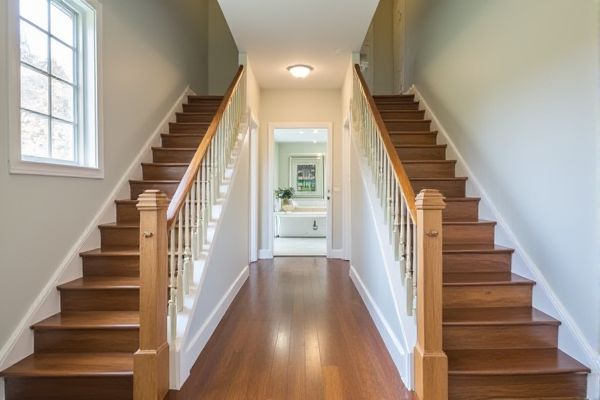
Painted banisters provide a smooth, vibrant finish that can easily match your home's color scheme, while stained banisters highlight the natural wood grain, offering a timeless and elegant look. Discover which option suits your style and maintenance preferences by reading the rest of the article.
Table of Comparison
| Feature | Painted Banister | Stained Banister |
|---|---|---|
| Appearance | Opaque, solid color finish | Transparent, highlights natural wood grain |
| Durability | Resists chips and scratches with proper paint | Shows wear easier but can be refreshed with stain |
| Maintenance | Easy to clean, may require repainting | Requires periodic refinishing to maintain look |
| Style | Modern, customizable color options | Classic, natural wood aesthetic |
| Cost | Usually cheaper initial cost | Potentially higher due to finishing process |
| Installation | Requires sanding, priming, painting | Requires sanding, staining, sealing |
Painted vs. Stained Banisters: An Overview
Painted banisters offer a smooth, uniform finish that can match any interior color scheme and effectively hide wood imperfections, making them ideal for modern or contemporary styles. Stained banisters highlight the natural grain and texture of the wood, enhancing its richness and providing a warm, classic look suited for traditional or rustic decors. Both options require different maintenance approaches: painted banisters may need touch-ups to address chipping, while stained banisters benefit from periodic resealing to preserve the wood's natural beauty.
Understanding the Aesthetic Impact
Painted banisters provide a bold, uniform look that can brighten staircases and complement modern interior designs, adding a sleek and contemporary aesthetic. Stained banisters highlight the natural grain and texture of the wood, offering warmth and timeless elegance ideal for traditional or rustic settings. Choosing between painted and stained finishes significantly influences the visual appeal and character of the stairway, aligning with the overall design theme and personal style preferences.
Durability and Maintenance Comparison
Painted banisters typically require more frequent maintenance, including chipping and peeling touch-ups due to their less durable surface compared to stained banisters, which show scratches and wear less noticeably. Stained banisters penetrate the wood, enhancing natural grain while offering better resistance to moisture and UV damage, resulting in longer-lasting finishes with minimal upkeep. For high-traffic areas, stained banisters maintain their appearance over time more effectively, reducing the need for frequent refinishing and extensive maintenance costs.
Color and Finish Options
Painted banisters offer a wide range of vibrant and customizable color options, allowing you to achieve a smooth, opaque finish that can match any interior design style. Stained banisters emphasize the natural wood grain, providing rich, warm tones with finishes that range from matte to glossy, enhancing the wood's texture and character. Your choice between painted and stained will depend on whether you prefer a bold, uniform color or a classic, wood-enhancing appearance.
Which Style Suits Your Home Decor?
Painted banisters offer a clean, modern look that complements minimalist, contemporary, or coastal home decor styles with their smooth, vibrant finish and color versatility. Stained banisters highlight the natural wood grain, making them ideal for traditional, rustic, or craftsman interiors where warmth and textured details enhance the overall aesthetic. Choosing between painted and stained banisters depends on whether your design favors bold color statements or the organic beauty of wood.
Cost Analysis: Painted vs. Stained Banisters
Painted banisters typically cost less upfront, with average prices ranging from $15 to $30 per linear foot, making them a budget-friendly option for homeowners. Stained banisters, priced between $20 and $50 per linear foot, often involve higher labor costs due to the detailed wood preparation and finishing processes. Your choice affects long-term maintenance expenses, as painted surfaces may require more frequent touch-ups, while stained banisters generally offer better durability and easier repair.
Pros and Cons of Painted Banisters
Painted banisters offer a sleek, modern look with a wide range of color options that can easily match any interior design style, while providing excellent coverage that hides wood imperfections effectively. However, painted surfaces are prone to chipping and scratches over time, requiring more frequent maintenance and touch-ups compared to stained banisters. Additionally, paint can obscure the natural grain and texture of the wood, which some homeowners might find less appealing than the authentic look achieved by staining.
Pros and Cons of Stained Banisters
Stained banisters preserve the natural wood grain, offering a warm, classic appearance while providing protection against moisture and wear. They require less maintenance than painted banisters, as scratches and nicks blend into the stain rather than peeling paint. However, stained banisters offer limited color options compared to painted ones and may darken over time due to exposure to sunlight.
Step-by-Step Guide: Painting vs. Staining a Banister
Painting a banister involves sanding the surface, applying a primer to ensure even coverage, and finishing with at least two coats of high-quality paint for durability and color vibrancy. Staining a banister requires thorough sanding to remove old finishes, applying wood conditioner to prevent blotching, and carefully applying stain followed by a protective clear coat to enhance the wood grain. Your choice depends on whether you prefer a smooth, colorful finish with paint or a natural, wood-enhancing look with stain.
Which Option Adds More Value to Your Home?
Stained banisters highlight natural wood grains, appealing to buyers seeking warm, classic aesthetics and potentially increasing home value by preserving original architectural elements. Painted banisters offer versatility in color choices, fitting modern or customized interior designs that can attract buyers wanting contemporary updates. Generally, stained banisters tend to add more long-term value due to their timeless, authentic wood appearance preferred in high-end homes.
 homyna.com
homyna.com